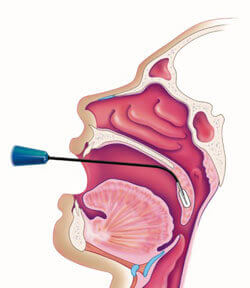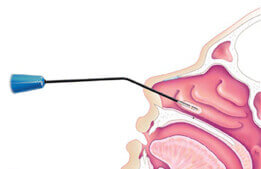Why Do You Snore?
When you sleep, air passages at the back of the nose and mouth become partially blocked. Snoring is the noise caused by air attempting to flow past the blockage. In many cases, this noise can fully or partially be traced to the soft palate – the area located on the roof of your mouth between the hard palate and the uvula. Chronic snoring is a common problem, and you are not alone. More than 45% of all adults snore occasionally, and 25% of adults snore consistently, causing millions of households to lose sleep nightly. Over 100 million people in the United States snore at least occasionally. For most, the condition is more annoying than dangerous but left untreated, snoring can worsen over time. Some patients who snore may also have sleep apnea, a potentially serious sleep disorder in which breathing repeatedly stops and starts.
What are Your Options?
A complete examination is the first step to snoring treatment. Our sleep apnea doctors at the Suburban Otolaryngology Center will check your nose and throat structures and evaluate factors such as weight, blood pressure and heart rate before recommending the best treatment plan for you. They may order a sleep study to make sure that you do not have sleep apnea. Many devices and procedures have been developed to temporarily control snoring. Non-surgical approaches, such as weight loss, lifestyle modifications, or oral appliances to reposition the jaw during sleep are possibilities. If you suffer from nasal congestion or enlarged turbinates, decongestants and nasal sprays may also be prescribed. There are also more aggressive and invasive surgical options for patients who don’t get relief from these conservative treatments.
More recently, a simple and quick procedure has been made available for the treatment of snoring called Coblation. This novel treatment can take as little as ten minutes and results in noticeable snoring improvement within 1-4 weeks.
How is the Coblation Snoring Treatment Performed?
With Coblation, your doctor removes and shrinks excess tissue inside the soft palate with a specially designed radiofrequency device. This outpatient procedure takes less than 10 minutes. Patients typically return home shortly after the procedure and can experience a noticeable reduction in snoring within one to four weeks. Watch the video below to learn more about palate coblation.

The procedure can typically be performed on an outpatient basis in your doctor’s office, under local anesthesia. A very low incidence of side effects, including minor swelling and sore throat, has been reported in some patients following treatment.
Coblation may also be used to treat another frustrating condition: Nasal Stuffiness.
Why is Your Nose Always Stuffy?
Nasal congestion can result from different conditions, including allergic rhinitis/sinusitis, septal deviation and/or hypertrophied turbinates. The physicians of the Suburban Otolaryngology Center will precisely diagnose the cause of your nasal stuffiness through a thorough endoscopic nasal examination in the office. An allergy test may be necessary to make sure that you do not suffer from allergic rhinitis. A CAT scan of the nose may be recommended to make sure that you do not suffer from sinusitis and/or nasal septal deviation. The appropriate treatment can then be provided. Sometimes, the cause of obstructed nasal airway passages is enlarged turbinates. Turbinates are small, bony structures located in the nasal airway covered with mucous membranes. Turbinates can become irritated, inflamed and enlarged, resulting in blocked nasal airway passages. This can be uncomfortable and annoying. Blocked nasal airway passages force you to breathe through your mouth, making simple everyday activities such as eating, speaking, and sleeping more difficult. If the enlarged turbinates do not respond to nasal sprays and/or decongestants/ antihistamines, Coblation may provide a simple solution. Coblation™ plasma technology for turbinate reduction is a medical innovation used to treat nasal airway obstruction by both removing and shrinking soft tissue inside the turbinates.
How is COBLATION™ Plasma Technology for Turbinate Reduction Performed?

The procedure can typically be performed on an outpatient basis in your doctor’s office, under local anesthesia. In such cases, patients typically return home shortly after the procedure. After the procedure, you will gradually experience a notable improvement in your nasal airway obstruction. As the turbinates continue to shrink over time, your ability to breathe will improve. Turbinate size can vary among patients. As such, it may occasionally be necessary to repeat the Coblation procedure to achieve maximum results.
The physicians of the Suburban Otolaryngology Center specialize in the treatment of snoring and nasal obstruction; they have successfully performed hundreds of radiofrequency coblation procedures of the turbinates and of the palate, and relieved symptoms form many grateful patients.










